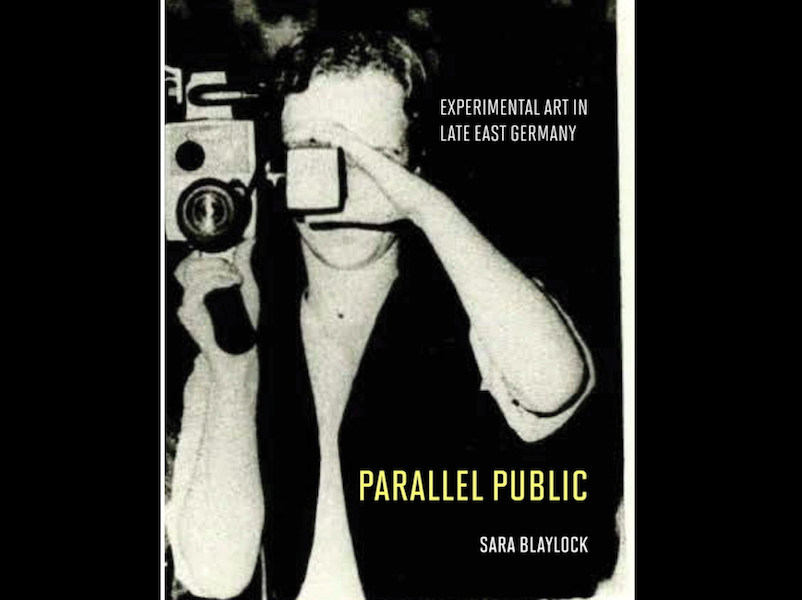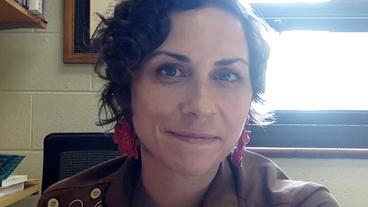Sara Blaylock, assistant professor of art history, is sharing her rediscovery of East German artists of the 1980s in a recent publication. Her book, Parallel Public: Experimental Art in Late East Germany (MIT Press, March 2022), is currently being celebrated with an art exhibition at the Tweed Museum of Art and the presentation of several lectures and events, including with the Busch-Reisinger Museum at Harvard and the School of the Art Institute of Chicago.
Unknown at the time to most of the world, hundreds of artists in the German Democratic Republic (GDR) created works of art through performances, photography, Super 8 film, graphics, and other media. Away from the eyes of Western art critics and art historians, these experimental artists practiced their art in front of the public. They performed in full view of the GDR police in those final decades before the Berlin Wall fell.
Blaylock’s book highlights the work of dozens of these artists. She calls out the story of one woman who was constantly in the eye of East Germany’s secret police: Gabriele Kachold Stötzer.
A photographer, filmmaker, and writer, Stötzer was a rebellious and radical artist. She spent a year in jail for circulating a petition that contested a state decision to expatriate a beloved artist, the singer Wolfgang Biermann.
“She went into prison as an activist, and came out an artist,” Blaylock says. Stötzer coordinated the GDR’s first feminist art collective, the Women Artists Group Exterra XX. She is just one of the artists profiled in Blaylock’s Parallel Public as well as in the exhibition at the Tweed.
“She started to bring women together to create art,” says Blaylock. “One of their films was called Frauenträume or Dreams of Women.” It's a series of vignettes that begins with an image of women sitting in rocking chairs with their backs to the camera. “At one point, Stötzer’s sister Ingrid is wearing a kaftan as she stands on top of the roof,” Blaylock continues. “The music in the background is an ethereal sound of birds. [Ingrid is] standing, she’s pretending to fly, and she feels really free, and that's her dream.”
From Stötzer's release from prison in 1978 to the present, she has been a force in the art world. In fact, Stötzer was part of the first group of people to occupy a Stasi headquarters in the wake of the fall of the Berlin Wall in Fall 1989. It is thanks to these efforts that the GDR’s secret surveillance files are available to us today. Blaylock addresses Stasi legacies in her book as well as in her exhibition at the Tweed.
Art on Display
UMD is featuring a unique exhibit as a companion to the book. Blaylock, along with Dr. Sarah James, a Gerda Henkel Professorial Fellow and recently named senior curator at the Tate Liverpool, has curated the exhibit in the Tweed Museum of Art. Entitled “Anti-Social Art: Experimental Practices in Late East Germany,” the exhibit debuted in January and runs until May 15, 2022.
The work in the Tweed references another exhibit in East Berlin which opened on May 30, 1989 and ran for an entire month at the state-run Galerie Weißer Elefant (White Elephant Gallery). “That opening was held just a few months before the Berlin Wall fell in November,” Blaylock says. “It was evidence that things were changing in East Germany in terms of what was permissible. I can't stress enough how public this work was.”
Few were aware of the cutting edge of East German performance art. Blaylock says the 1989 exhibit featured an artist “wearing a sadomasochistic mask made out of a sort of a plaster and he cuts holes in it to show the brains behind it. Probably the most shocking piece,” was another artist "dipping her head in pig’s blood."
The art was a product of the frustration of artists who were locked in a city behind a wall. At the same time, “the official culture [authorities] permitted East German artists to put on an exhibition for a whole month with lots of programming,” Blaylock says. The 1989 exhibit was a clear example of the political climate leaning toward freedom.
Opportunities for Learning More
Several events are related to the exhibition, including a UMD Visual Culture Lecture Series (held February 8).
March 26: Coming up is a Community Day with art education students at the Tweed Museum of Art on Saturday, March 26 from 11 am to 2 pm.
April 5: The UMD library will host Blaylock in a book reading on April 5 from 3-4:15 pm in the Fourth Floor Rotunda. The event, entitled "Culture and Social Value in Postwar Britain and Communist Germany" will also feature the recent release of Reconstruction Fiction: Housing and Realist Literature in Postwar Britain, the first book by Paula Derdiger, associate professor in the UMD Department of English, Linguistics, & Writing Studies.
April 20: An interview with Gabriele Stötzer will be held in two languages, English and German, via Zoom on April 20, 2022. Email [email protected] for more information about the Stötzer interview.
Interest and Opportunity
German art, especially East German art from the 1980s has fascinated Blaylock for over a decade. Her research resulted in conference presentations and journal publications as early as 2012.
In fact, Blaylock's work has been supported from the start by national and international funders, including the German Academic Exchange Service (DAAD) and the College Art Association. Importantly, a Grant-in-Aid from the University of Minnesota has funded Blaylock's exhibition at the Tweed.
She has published widely on the subject in academic and arts forums, and the Historians of German, Scandinavian and Central European Art have just awarded her its Emerging Scholars Prize for her text on Cornelia Schleime’s Stasi Series. This work is also featured in the Tweed exhibition. Parallel Public is her first book.
About the UMD B.A. in Art History
Banner Photo (above): Cover of the book, Parallel Public: Experimental Art in Late East Germany

